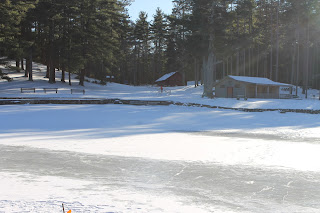Location Information: Peck Pond, Pulaski State Park, Glocester, RI
Chepachet, RI 02814
Mailing Address:
George Washington Management Area Headquarters2185 Putnam Pike
Chepachet , RI 02814-1705
Other Information:
Make a reservation at Pulaski State Recreational AreaView a map of Pulaski State Park's ski trails
Parking: Electric vehicle charging station available for 4 hours max while enjoying the park or other facility. The EV station does not guarantee a space on full capacity days.
Reservations are required for use of the Pavilion. Walk in rentals will still be acceptable when available. Contact the Recreational Area headquarters for more information.
Florescent orange requirements apply for all users during hunting season.
The cross-country ski program depends on snow conditions; trails close at 3:30 p.m. Call for conditions.
The use of boats or any flotation devices in Peck Pond is strictly prohibited.
Located within the 4000 acre George Washington Management Area, the 100 acre Pulaski Memorial Recreation Area is a "day use" facility offering users a multitude of opportunities to enjoy the outdoors. From the first class trout fishing in the spring, to enjoying a picnic, a short hike, or a cool swim in the 13 acre Peck Pond in the summer, to cross-country skiing on the 10 miles of groomed trails into the adjacent George Washington Management area in the winter, Pulaski provides year round enjoyment for all ages.
The Pond is called Peck Pond and borders Thompson, Conn and Glocester, RI and the Counties are Windham, Conn. and Providence County, RI.
Physical features; 13 Acres with a maximum depth of 14 feet. Basin is manmade and a average depth is 4.7 feet. No fall draining on this moving water with a very pretty bridge to join the two States.
Known fish population: Largemouth Bass,Golden trout, Chain pickerel and red fin pickerel, brown bullhead, golden shiner, yellow perch, common sunfish and stocked salmonids, spring and fall.
Ice Fishing: This beautiful body of clean water is the first to lock-up in the Ocean State for early ice fishing. Use smaller shiners and pinheads along with your popular hardware for some great perch jigging sweetened up with a meal worm or dillie. Some days great for a hike or snow shoeing, cross county, snow shoeing or use the pinetree shade in the hot summer for a old fashion affordable picnic and a dip. Bathrooms in warm weather and a outhouse for winter use was open today.

























 the property, however, the easement did not guarantee public access and also contained a right for the construction of a single residence. Now the right to public access for hunting, fishing, trapping, and other wildlife-related recreational activities is permanently protected.
the property, however, the easement did not guarantee public access and also contained a right for the construction of a single residence. Now the right to public access for hunting, fishing, trapping, and other wildlife-related recreational activities is permanently protected.


